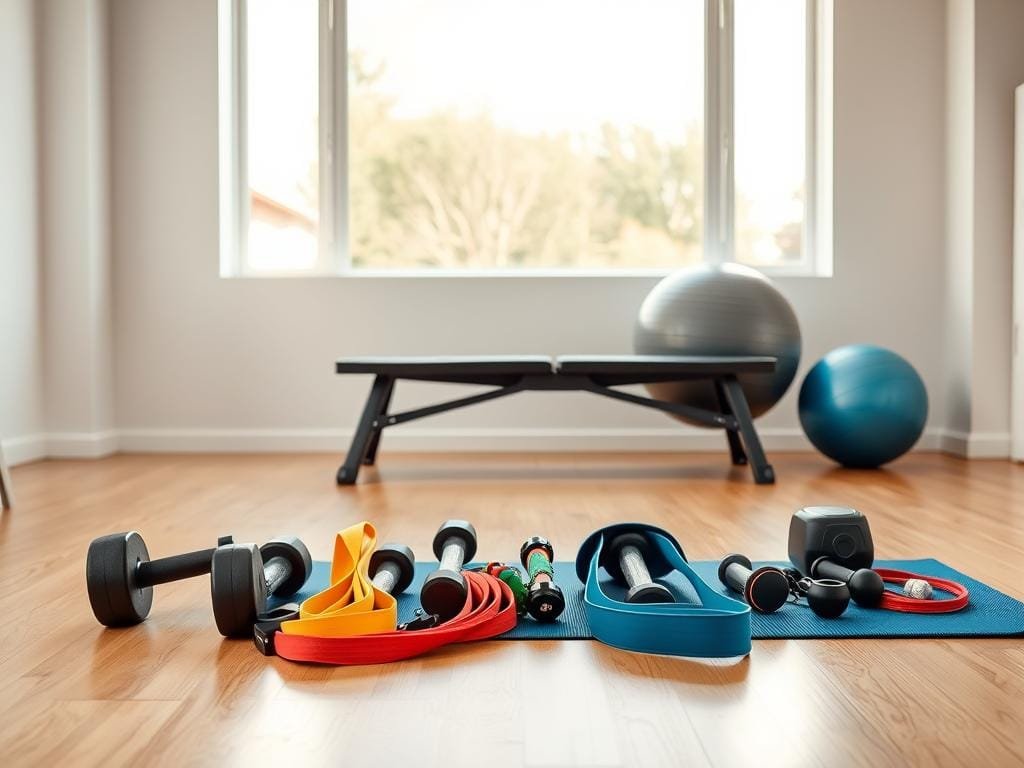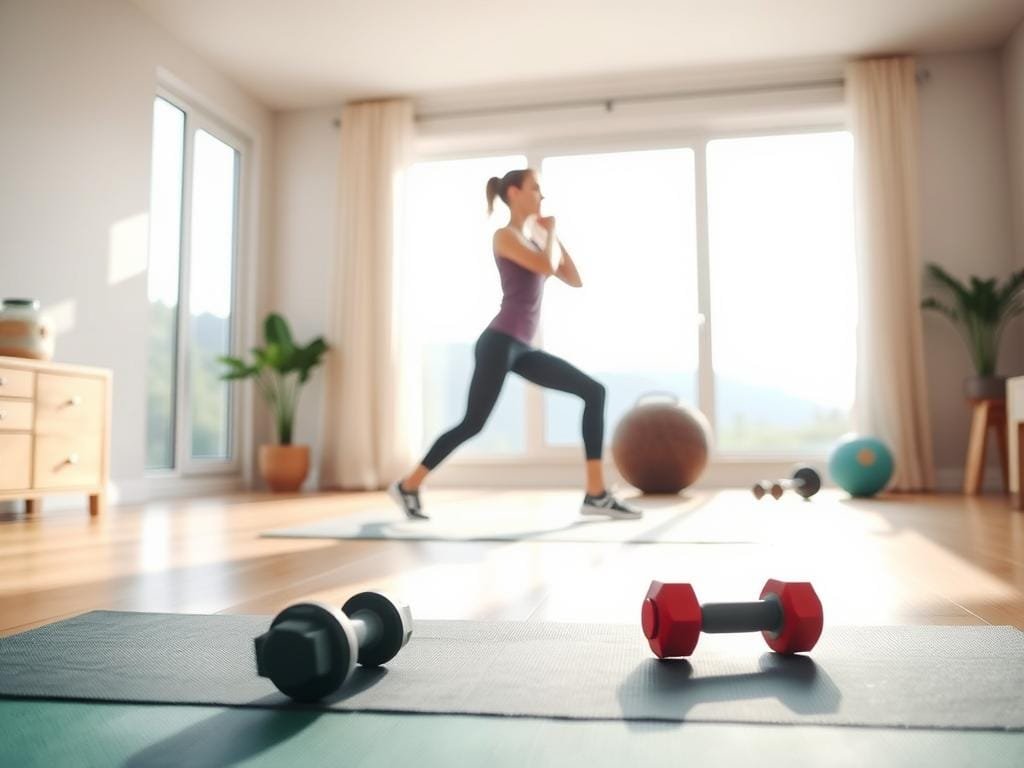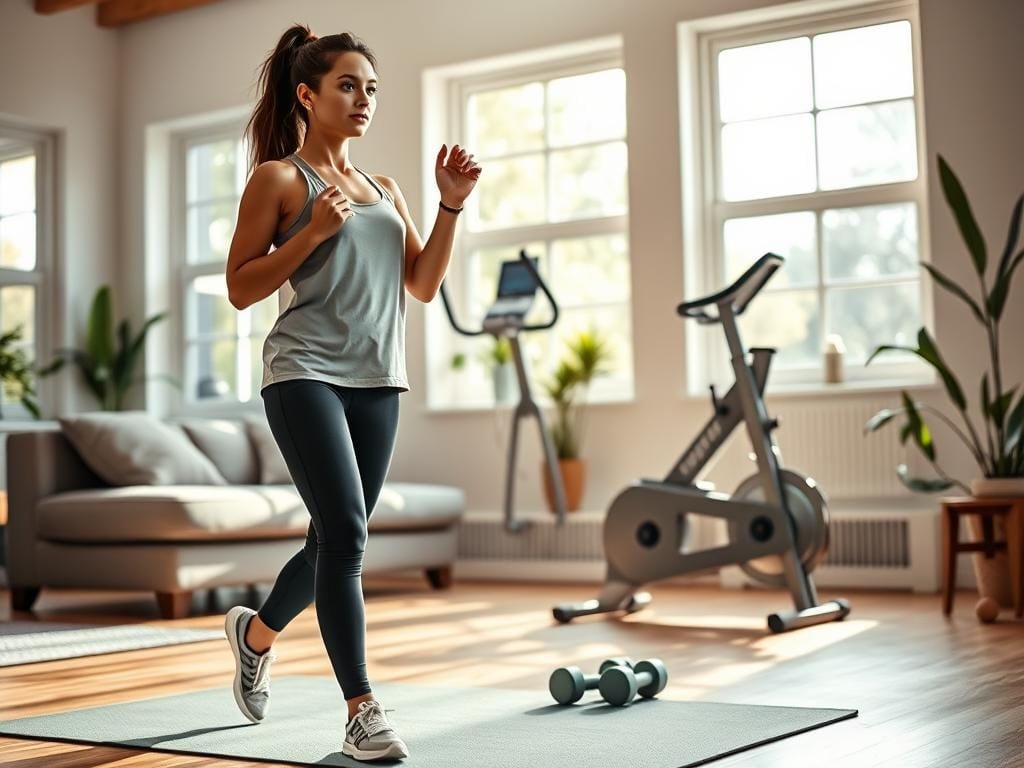Boost your health and live longer with just a few minutes each day. A 2011 study showed that 15 minutes of moderate exercise daily can add years to your life. It also lowers the risk of dying early.
Imagine having a personalized fitness guide that fits your needs. It’s great whether you’re starting out or want to push yourself harder. Our guide has 3 routines, 36 progressions, 6 sample workouts, and 3 enhancements to help you reach your fitness goals.
This flexible and adaptable guide is perfect for beginners exercising at home. You can adjust it to fit your fitness level. It’s a great way to start your journey to a healthier you.
Table of Contents
Understanding the Benefits of Home Workouts
Working out at home offers flexibility, convenience, and many other benefits that can boost your fitness journey. You can avoid the gym’s schedule and environment by exercising at home.
Flexibility and Convenience
Home workouts are very flexible. You can exercise at any time that fits your schedule. This makes it easier to keep up with your routine, even on busy days.
Also, you save time and energy by not having to go to the gym. Just step into your home gym and start exercising.
Cost-Effectiveness
Home workouts are also budget-friendly. You don’t need to spend money on gym memberships or travel costs. You can get a great workout with bodyweight exercises or minimal equipment you probably have at home.
“You can do so much with body weight and stuff you have in your house. And you can absolutely get an amazing workout in.”
Privacy and Comfort
Exercising at home gives you privacy and comfort that gyms often lack. You can work out in your own space, at your own pace, without feeling self-conscious.
This comfort and privacy can help you stick with your workout routine and enjoy improving your fitness.
Essential Equipment for Beginners
Starting a home workout routine doesn’t need a lot of equipment. You don’t have to buy a whole gym to begin. Focus on basic, versatile gear to start your beginner home workout tips.
Choosing Your Gear Wisely
When picking out equipment, think about your fitness goals and the exercises you want to do. Beginners should start with the basics and add more as they get more comfortable.
- A good quality yoga mat for comfort and grip during various exercises.
- Resistance bands or light dumbbells for strength training.
- A sturdy chair or bench for support during squats, lunges, or step-ups.
Must-Have Basics for Home Workouts
For basic workouts for beginners at home, you need a few key items. Make sure you have a clear space for exercises like squats and push-ups. A doorway pull-up bar or ledge is great for upper body strength.

Other essentials include a jump rope for cardio and a stability ball for core exercises. These are effective, affordable, and don’t take up much space.
Optional Equipment for Extra Challenge
As you get better, you might want to add more equipment to challenge yourself. Some good options are:
- Kettlebells for dynamic strength training.
- A pull-up bar for upper body workouts.
- A balance board or BOSU ball for improving balance and stability.
These extra pieces can make your workouts more interesting and prevent boredom. The most important thing is to stay consistent and keep getting better.
Structuring Your 15-Minute Workout
To get the most out of a 15-minute home workout, plan your exercises carefully. It’s key to structure your workout to cover your whole body.
Warm-Up Techniques
Begin with a dynamic warm-up to get your muscles ready. A 3–5 minute warm-up can lower injury risk and boost performance. Try leg swings, arm circles, and torso twists.
Balanced Exercise Routines
Your routine should mix strength training, cardio, and flexibility exercises. For a 15-minute workout, warm up for 5 minutes, do the main exercises for 7-8 minutes, and cool down for 2-3 minutes. This covers all fitness areas.
Beginners can start with bodyweight exercises like squats, push-ups, and lunges for strength. For cardio, try high-intensity interval training (HIIT) with burpees or jump squats.
Effective Cool-Down Strategies
Cooling down is vital for recovery and easing muscle soreness. Spend a couple of minutes on static stretches for the muscles you used. Hold each stretch for 15-30 seconds and breathe deeply.
Good cool-downs help with recovery and improve flexibility. Adding deep breathing exercises can also help relax and reduce stress.
Full-Body Warm-Up Routine
Before starting your home workout, it’s important to warm up your body. This step helps prevent injuries and boosts your workout performance.
Dynamic Stretches to Begin
Dynamic stretches are movements that match your workout. They increase blood flow and muscle temperature, making you more flexible. Start with Neck Circles, tilting your head in circles. Do this 5 to 15 times in each direction.
Other stretches include Arm Circles and Hip Circles. For Arm Circles, hold your arms straight and make small circles with your hands. Start small and get bigger. Hip Circles involve moving your hips in a circle while standing with your feet together.
Low-Impact Movements to Prepare
Low-impact movements are gentle exercises that get your heart ready for more intense activities. They’re great for beginners or those coming back to exercise. Examples are marching in place, leg swings, and light jogging in place.
Here’s a structured warm-up routine:
| Exercise | Duration | Repetitions |
|---|---|---|
| Neck Circles | 30 seconds | 5-15 each direction |
| Arm Circles | 30 seconds | 5-15 each direction |
| Hip Circles | 30 seconds | 5-15 each direction |
| Leg Swings | 30 seconds per leg | 10-15 swings |
For more warm-up and stretching exercises, check out darebee.com.
Tips for Staying Motivated
Staying motivated is key to a consistent workout routine. Vary your warm-up to keep it interesting. Try different stretches or movements. Also, track how your body feels during and after workouts.
Set small, achievable goals for your workouts. Celebrating these small wins can boost your motivation and keep you going on your fitness journey.
Strength Training Exercises for Beginners
To start strength training at home, learn the basic exercises for beginners. Strength training is key for building muscle and improving health. You can start with simple exercises that don’t need special equipment.

Bodyweight Exercises to Start
Bodyweight exercises are a great start for your strength training. They are easy, need no equipment, and can be done anywhere. Some good exercises for beginners include:
- Squats: Works your lower-body muscles, including quads, glutes, and hamstrings.
- Push-ups: Targets your upper-body muscles, including chest, shoulders, and triceps.
- Lunges: Another effective exercise for your lower body, lunges help improve balance and strength.
These exercises are excellent for building a strong foundation. For a more detailed workout plan, check out a 31-day strength training plan for beginners.
Incorporating Dumbbells and Resistance Bands
As you get better, add dumbbells and resistance bands to your routine. These tools make your workouts more challenging and help you progress. For example, you can use dumbbells for:
- Dumbbell rows: Targets your back and arm muscles.
- Dumbbell shoulder press: Works your shoulder muscles.
Resistance bands are lightweight, portable, and easy to use. They’re perfect for adding resistance to your bodyweight exercises or creating new ones. For more ideas, see this guide on the best muscle-building workout plan.
Key Muscle Groups to Target
When starting a strength training program, focus on key muscle groups. This includes:
| Muscle Group | Exercises |
|---|---|
| Lower Body | Squats, Lunges |
| Upper Body | Push-ups, Dumbbell rows |
| Core | Planks, Russian twists |
By focusing on these muscle groups, you’ll get a balanced workout. This improves your overall strength and fitness.
Cardio Workouts You Can Do at Home
Home cardio workouts are easy and effective for heart health. You can get great results without going to the gym.
High-Intensity Interval Training (HIIT)
HIIT boosts heart fitness by mixing intense exercise with rest. You can pick a work-rest ratio like 40/20, 30/30, or 20/40 based on your fitness.
Sample HIIT Workout: Sprint in place for 30 seconds, then rest for 30 seconds. Do this for 15 minutes, adjusting as you get better.
| Exercise | Duration | Rest |
|---|---|---|
| Sprinting in Place | 30 seconds | 30 seconds |
| Jumping Jacks | 30 seconds | 30 seconds |
| Burpees | 30 seconds | 30 seconds |
Low-Impact Cardio Solutions
For those who prefer easier exercises or are new, there are many low-impact options. Try brisk walking, jogging in place, or cycling at home.
Tips for Effective Low-Impact Cardio: Make sure you move fast enough to keep your heart rate up during your workout.

Choosing the Right Workout for You
When picking a cardio workout, think about your fitness level and goals. Beginners should start with easier exercises and slowly increase the challenge.
Key Considerations:
- Your current fitness level
- Your cardiovascular health
- Your personal preferences regarding exercise intensity
Choosing a workout that fits you helps you stay consistent and reach your fitness goals.
Flexibility and Cool-Down Techniques
To get the most out of your 15-minute home workout, it’s key to add flexibility and cool-down exercises. These help prevent injuries and speed up recovery. They’re a must for your home workout routines for beginners.
Importance of Stretching Post-Workout
Stretching after your workout is key for keeping muscles flexible and easing soreness. It stretches muscles and boosts range of motion. When you stretch post-workout, you’re helping your muscles recover from the effort.
Here are some beginner home workout tips for effective stretching:
- Focus on major muscle groups such as hamstrings, quadriceps, and hip flexors.
- Hold each stretch for at least 20-30 seconds.
- Breathe naturally and avoid bouncing.
Common Stretching Mistakes to Avoid
Stretching is great, but beginners often make mistakes. Knowing these mistakes can make your stretching better.
| Mistake | Correction |
|---|---|
| Bouncing while stretching | Stretch to a comfortable point and hold |
| Not breathing properly | Breathe deeply and naturally while stretching |
| Stretching too aggressively | Stretch to a point of mild tension, not pain |
Effective Cool-Down Moves
Cooling down after your workout is as important as the workout itself. Good cool-down moves help your body relax and reduce muscle stiffness. They also improve flexibility.
Some easy exercises for beginners at home that work well for cooling down include:
- Walking in place or light jogging
- Leg swings and arm circles
- Deep breathing exercises
Adding flexibility and cool-down techniques to your home workout routines for beginners will improve your workout experience. You’ll see better results too.
Tracking Your Progress
Tracking your progress is key to sticking with your at home exercise for beginners routine. Seeing how far you’ve come and what you need to work on is motivating.
Setting Realistic Goals
Setting achievable goals is the first step to a successful workout plan. When starting beginner-friendly home workouts, define what you want to achieve. This could be losing weight, getting more endurance, or building strength.
To set realistic goals, consider the following:
- Be specific about what you want to achieve.
- Make sure your goals are measurable.
- Ensure your goals are attainable based on your current fitness level.
- Set deadlines for achieving your goals.
Using Apps and Tools to Monitor Success
Today, many apps and tools can track your progress in basic workouts for beginners at home. From fitness trackers to workout journals, they offer valuable insights.
Using a workout journal can be a great motivator. It helps you log your exercises, track your workouts, and note your progress. This can help you identify patterns or areas for improvement.
| Tool | Description | Benefits |
|---|---|---|
| Fitness Trackers | Wearable devices that monitor heart rate, steps, and calories burned. | Real-time data, motivational insights. |
| Workout Apps | Mobile apps that offer various workouts and tracking features. | Convenience, variety, progress tracking. |
| Workout Journals | Physical or digital logs to record workouts and progress. | Personalized tracking, reflection, motivation. |
When to Adjust Your Workout Routine
Knowing when to adjust your at home exercise for beginners routine is important. If you’re not challenging yourself enough or not seeing results, it’s time to make changes.
Consider adjusting your routine if:
- You’ve plateaued and aren’t seeing any further progress.
- Your goals have changed, requiring a different focus.
- You’ve become comfortable with your current routine.
By regularly assessing your progress and making necessary adjustments, you can continue to challenge yourself and achieve your fitness goals.
Staying Motivated and Committed
Staying motivated for home workouts can be tough. It’s important to keep a regular routine and find ways to stay interested.
Creating a Home Workout Schedule
Choose a time each day for your workout and stick to it. Adding your workout to your morning routine can make your day better. For tips on creating a good workout plan, visit Boost Healthy Life.
Being consistent is key to seeing results. Scheduling your workouts helps you move closer to your fitness goals.
Finding Workout Buddies
Having a workout buddy boosts your motivation. You can find friends online or locally. For more ideas, check out Blendtec’s 10 Ways to Stay Motivated.
Working out with others makes it more fun and keeps you on track.
Rewarding Yourself for Achievements
Reaching milestones deserves a reward. It could be a new workout outfit or a relaxing bath. Celebrating your success keeps you motivated.
By using these tips, you can stay motivated and reach your fitness goals.
Common Challenges for Beginners
Starting to exercise at home can be tough. When you begin with simple workouts, you’ll face many challenges. These can slow down your progress.
Overcoming the Fear of Starting
One big challenge is starting a new exercise routine at home. It’s normal to feel scared about trying something new, even if you’re new to working out.
To get past this fear, set small goals. Start with a 5-minute workout each day. As you get more comfortable, you can do longer and harder workouts.
“The greatest wealth is health.” – Virgil
Dealing with Time Constraints
Many beginners find it hard to fit in workouts. But, even busy people can do short, effective workouts.
Try high-intensity interval training (HIIT). It’s short bursts of hard exercise with brief rests. You can do it in 15 minutes, great for tight schedules.
| Day | Workout Type | Duration |
|---|---|---|
| Monday | HIIT | 15 minutes |
| Wednesday | Yoga | 10 minutes |
| Friday | Strength Training | 20 minutes |
Managing Plateaus in Progress
Plateaus happen to everyone. If you’re not seeing progress, it’s time to change things up.
Switch your workout every four to six weeks. Try new exercises, increase intensity, or change workout types. For example, add dumbbells or resistance bands to bodyweight exercises.
Knowing these challenges and how to overcome them will help you stay on track. You’ll reach your fitness goals with your at home exercise routine.
Additional Resources and Support
As you keep up with your beginner-friendly home workouts, having the right resources is key. You’ll need support to stay motivated and reach your fitness goals. Look into online communities and classes for beginners. They offer guidance and encouragement on your fitness journey.
Online Communities and Fitness Classes
Online fitness communities are a great place to meet others who share your fitness goals. You can share your experiences and learn new workouts to do at home. Join virtual fitness classes, ask questions, and get help from certified trainers and experienced members.
Recommended Fitness Apps
Fitness apps can help you track your progress and stay motivated. They offer beginner-friendly workouts, including video tutorials and personalized plans. Explore these apps to find the one that suits you best.
If you have physical limitations or injuries, talk to a physical therapist or certified personal trainer. They can help create a workout plan just for you. For more details on our terms and policies, visit our Terms of Use page.

